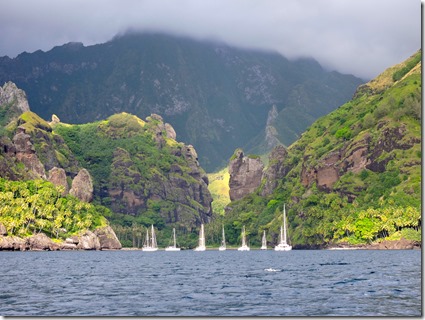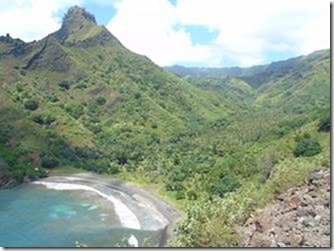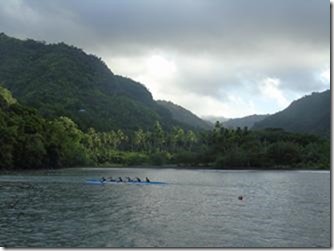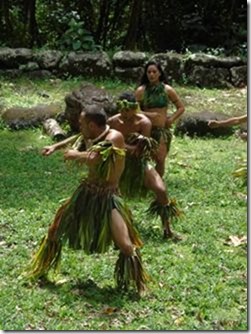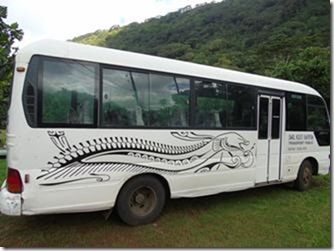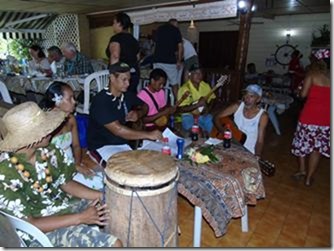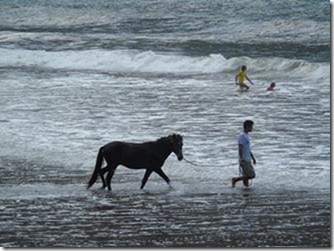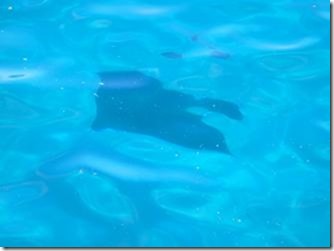Marquesas Summary

|
08:54.93S 140:06.04W
Nuku Hiva
8 May 2015
The Marquesas, famed for their ferocious inhabitants, warriors and cannibals, who deterred attempts of subjugation by Europeans for many years during the 18th and 19th centuries, were brought to the attention of the World by Herman Melville’s seminal novel – Typee – which told the semi-autobiographical tale of life among the Marquesans who, Melville describes, as being sophisticated and enjoying a long cultural tradition of which cannibalism played only a small role. The islands were later described in some detail by Robert Louis Stevenson in his South Sea Tales and related writings. More recently the islands also achieved renown as the resting place of the French impressionist, Paul Gauguin, whose melancholic images depict both the beauty of the islands and their inhabitants as well as the sense of loss and disorientation that pervaded their existence at the time having suffered, as a result of the European contact, a catastrophic collapse in population as well as dislocation from their ancient traditions and culture. A further literary association was created by Thor Heyerdahl’s Fatu Hiva which relates his attempt in the 1930’s to “return to nature” and live dissociated from the modern world. During his time on the island he developed his ideas that the islands were populated from the East and which later gave rise to his Kon Tiki adventure. So our own arrival on Fatu Hiva was full of expectation and excitement. We were not disappointed. Firstly one cannot fail to be impressed by the extraordinary landscape. It is truly hard to find words to describe the massive cliffs, covered in green foliage, rising vertically from the sea and with their peaks lost in the clouds, lofty knife-edge ridges high in the sky surrounding verdant valleys full of coconut palms and fruit trees, and the scattering of houses that comprise a village, dwarfed by its surroundings. Time and again we fell into clichéd superlatives - awe-inspiring, jaw-dropping, fantastic, magnificent – in response to the sights that greeted us. While each of the islands has its own personality, Fatu Hiva, being small and remote, appears to embody all that is mysterious and foreign about the archipelago. Hanavave, the principal anchorage, is truly exceptional: tall spires of vertical rock rise on each side of a narrow valley, casting their shadows across the village, while between them a gentle stream flows into the sea from the upper reaches of the valley yet which lie hidden from view, creating an impression of haunting beauty and foreboding. The other islands each present their own variation on this theme. Hanavave, Fatu Hiva
North Coast of Hiva Oa
Tahauko Bay, Hiva Oa Hataheteu Bay, Nuku Hiva Anaho Bay, Nuku Hiva Daniels Bay, Nuku Hiva
Hakatao, Ua Pou
The Marquesan people, while being undeniably Polynesian, pride themselves in their individual and independent history. It is generally accepted that the peoples of both Hawaii and Easter Island originated from the Marquesas during the age of the great Polynesian voyaging. Consequently the Marquesans rightly regard their language and culture as the root of a rich and fruitful blossom. Today much emphasis is placed on reviving this heritage through numerous gatherings to perform song, dance and talk as well as to participate in a variety of unusual sports, of which a couple we found to be particularly unique: racing while carrying a branch of bananas (20 kg), and throwing javelins at coconuts up the tree. We didn’t actually witness these but we did have the opportunity to attend an event to select a representative from the Marquesas to compete later in the year in Tahiti to perform tapa tapa. A stage was erected on the tohua (traditional ceremonial meeting area) on the shore, lights set up, sound systems installed, TV cameras, etc. In addition various food stands opened for business with fires burning and delicious aromas which appeared to attract the entire population of the island to witness the event. Night fell and at the appointed time the festivities began with drumming, dancing, singing and speeches in Marquesan and French. This was to be a children’s competition between the six islands in the group and there were a number of troupes of boys and girls dressed for the occasion largely in traditional garb of grass skirts, woven palm, flowers and feathers. Among them there were also some “stars” in elaborate costumes. These were the competitors. At last the final speech was over and a burst of drumming signalled that it was time to begin. The first competitor made her way onto the stage with a graceful “bird dance”. Tapa tapa is essentially the declamation of a mythological story, accompanied by gestures and, sometimes, dance in order to add drama to the storytelling. The rules of the competition insist that the performance lasts a minimum of fifteen minutes, so we are not talking about a couple of versus of poetry, or even a long soliloquy from Shakespeare. Fifteen minutes takes up a lot of words that needs to be memorised and the competitors were aged about 8 to 11 years old – quite a challenge. The performances were spellbinding and each quite different from one another. Being in the Marquesan tongue we couldn’t follow the text too well although there was frequent reference to paddling canoes, appeals to the sky (god?) and fighting off evil spirits, judging from the gesturing. Altogether, the setting, the performances, the costumes and the ambience were unforgettable and a wonderful introduction to the vibrant present day culture. Sadly my camera was unable to capture these images but fortunately we had the chance to witness some more drumming, singing and dancing on another occasion held at the tohua at Hatiheu for the benefit of the passengers on the supply ship, the Aranui.
The islands also bear witness to the ancient culture with countless archaeological sites. Some are quite modest – just the remains of a paepae which is the stone platform on which wooden houses would have been erected. In some places these paepae are still in use with a modern house sitting on them. At the other end of the spectrum are the sites that comprise a ceremonial and temple complex with numerous paepae, tohua and me’ae (like a paepae but intended for a sacred purpose) together with tikis, the omnipresent statues of demigods. We were fortunate to make the acquaintance of Pierre Ottino, a French archaeologist who has been responsible for the excavation and restoration of many of these sites, and our understanding of the sites and their history was greatly enhanced by his kind explanations. Modern tikis at Omoa, Fatu Hiva
Puama’u ceremonial site, Hiva Oa
Smiling tiki, Makamea, Hiva Oa
Petroglyphs, Hiva Oa
Pierre Ottino at Te Moui, Hatiheu, Nuku Hiva
Pa’eke, Taipivai, Nuku Hiva
Another current _expression_ of this cultural heritage is the art of tattoo. Most of the men and a large section of the women sport tattoos of various sorts, but all incorporating traditional motifs of which there are over 1,000. By contrast, the tattoo of Tahiti or Hawaii have only a fraction of this number of motifs. Each motif carries a meaning and the skill and artistry of the tattooist entails creating a design that is suited to the person. A person’s tattoo, therefore, is a work in progress and new sections are added during a person’s lifetime to reflect events and developments such as marriage, children, the death of family members or friends, travel, new interests, achievements, and so on. Many of the yachtsmen who pass through the islands depart with a tattoo as memento of their visit. If a tattoo is not to one’s taste, then there is the opportunity to buy wonderful carvings and other handicrafts which are also encouraged with official support. The carvers work in wood, stone and bone to create objects ranging from items of jewellery to monumental sculptures. Their work is to be found everywhere as most buildings will have carved posts or entrance portals and incorporate many of the same motifs to be found in the tattoos, as well as tikis, of course. Marc’s studio, Fatu Hiva
Fermin, Hapatoni, Tahuata Tohua Koneva, Nuku Hiva
Modern tohua at Taipivai
Tatoo design on school bus!
The high islands are extremely fertile and give rise to an abundant supply of foods: bread fruit, coconut, sweet potato and taro are the traditional staple foods – and fish, of course. Add to this mango, grapefruit, papaya, limes, oranges, bananas, vanilla, ginger etc. all of which grow in profusion. In terms of livestock, there are chickens – everywhere – cattle, pigs, goats. There are also market gardeners producing salads, carrots, onions and potatoes. In spite of all this local supply, large amounts of rice and wheat flour are imported to cater to modern tastes. Elizabeth tried her hand at various local recipes of which her pokay, a pudding made from tapioca flour and fruit, found great favour aboard. Our real treat, though, was a kai umu, a feast with pigs prepared and cooked in a traditional oven of hot stones in a pit, then covered with banana leaves and palm fronds. This was served in the restaurant Chez Yvonne in Hatiheu. The restaurant has rooms and we stayed there a couple of nights, spending many hours in conversation with Yvonne whose restaurant has been serving visitors for over 40 years. Understandably the restaurant, and Yvonne herself, are something of an institution. She serves as the mayor of the village and seems to be tirelessly engaged in many a committee to improve the conditions of her village as well as to promote culture. Nevertheless she was very willing to spend time with us and give us insights into developments over the years. Together with Pierre Otoni, she has created a small museum of priceless artefacts from local archaeological sites and had furthermore organised a squad of soldiers to come to the village during our stay in order to erect some huts in the traditional style on the ancient tohua. Kai Umu at Chez Yvonne
Horses are another feature of the islands since roads are few and the paths through the forests are very steep and heavy going. So you will find horses in every back yard, along roadsides and in the forests. They are used by young and old for personal transport and for carrying goods, especially coconuts. There are coconut trees everywhere, some in well tended plantations but mostly in overgrown forest areas. We were warned that every tree belongs to someone so that we should be careful before helping ourselves. Indeed the nuts are collected, husked and the meat set out to dry as copra. This is a cash crop to which almost every citizen has access. The copra is purchased at an inflated and state-subsidised price and then collected by the supply ships that visit the islands approximately once a month.
Surprisingly, the swimming in the Marquesas was a bit disappointing. In spite of their position in the tropics, there is little coral and no reef around the islands. Just why this is so remains a mystery to me; I was unconvinced by the standard explanation that the seas are affected by cold currents. However the fact remains that reef fish are in short supply and the seas are murky and green in colour. The plus side of this is that the manta rays seem to love it. Time and again we would find ourselves in a bay with these huge creatures circling around us or doing the loop-the-loop as they gobble up the micro-organisms. Just beautiful.
During six weeks we were able to visit each of the major islands and never ceased to be impressed by the extraordinary natural beauty of the islands and mountains, the dignity and warmth of the people and the wonderful cultural heritage which they enjoy. As we weighed anchor and set off for the Tuomotus, or Dangerous Archipelago, we vowed to return one day. Blue Planet Odyssey: Our participation in the rally ended once we arrived in Hiva Oa since we had only signed up to go this far while the others were, for the most part, headed around the World. We decided to throw a party on LS for all and sundry to celebrate our safe arrival and to say goodbye. E had cleverly arranged a supply of drinks and nibbles in advance and a good time was had by all, including our intrepid friends from the little Norwegian boat, Mila!
Boat Stuff: Once we arrived in the Marquesas, things started to go wrong. Thank goodness it was that way around and we didn’t have these problems on the passage. Topping lift: This had chafed through on passage and we were able to sort that out, thanks to B who made several trips up the mast first to free the line that was jammed inside the mast, and then to refit it. Mainsail headboard car: As we lowered the main sail in Fatu Hiva the car fell off the mast track – broken. Oh bother! We were unable to hoist the main until we replaced it so an urgent search first to identify the item and then to get a new one delivered. Thanks to the valiant assistance of Kevin, of Nuku Hiva Yacht Services, we got a new one a month later. Watermaker: Although it made all the right sounds, no fresh water was coming out. Experts were consulted and new pumps were ordered from America via Tahiti. In the meantime we had to do without and that meant filling up jerry cans whenever we came across a fresh water supply. This often meant taking the dinghy to the shore, landing on the beach, carrying the cans to a faucet and then lugging them, all 100 litres of them, back to the boat. Showers were strictly rationed! A month later, the new pumps arrived and once fitted, it was still the same. Oh bother! So it was back to our own devices. B & M took it apart and kicked it. That fixed it.
Cooker: The gas supply wasn’t working properly and we kept discarding gas bottles, thinking they were empty. No, it was the regulator and Kevin, our hero, had us up and running again quickly and then found a new regulator for us. Generator: This went on the blink and wouldn’t run, displaying an error message that the motor was overheating. With the help this time of Vincent, the resident aero engineer from Nuku Hiva airport, we tracked this down to a faulty sensor. Problem solved. Hatch cover: Yes, thanks to the kind assistance of Barney Pinney, our replacement hatch cover arrived and so we were able to fix that. Bungles’ kite spares: Yes, and they arrived too, so kite surfing went back on the menu. Oh boy, yachts and yachting! Thankfully we had the time to wait for these bits and pieces to arrive but it would have been a different matter if we had remained on the Blue Planet schedule. Fingers crossed, let’s hope things will run smoothly for the rest of the time. M
|
